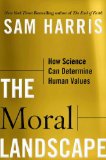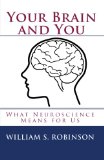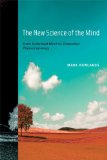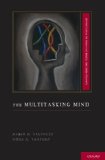October 6, 2010

The Moral Landscape: How Science Can Determine Human Values by Sam Harris (Free Press, 2010)
(link for amazon.co.uk)
Product description from the publisher:
Sam Harris’s first book, The End of Faith, ignited a worldwide debate about the validity of religion. In the aftermath, Harris discovered that most people—from religious fundamentalists to nonbelieving scientists—agree on one point: science has nothing to say on the subject of human values. Indeed, our failure to address questions of meaning and morality through science has now become the most common justification for religious faith. It is also the primary reason why so many secularists and religious moderates feel obligated to “respect” the hardened superstitions of their more devout neighbors. In this explosive new book, Sam Harris tears down the wall between scientific facts and human values, arguing that most people are simply mistaken about the relationship between morality and the rest of human knowledge. Harris urges us to think about morality in terms of human and animal well-being, viewing the experiences of conscious creatures as peaks and valleys on a “moral landscape.” Because there are definite facts to be known about where we fall on this landscape, Harris foresees a time when science will no longer limit itself to merely describing what people do in the name of “morality”; in principle, science should be able to tell us what we ought to do to live the best lives possible. Bringing a fresh perspective to age-old questions of right and wrong and good and evil, Harris demonstrates that we already know enough about the human brain and its relationship to events in the world to say that there are right and wrong answers to the most pressing questions of human life. Because such answers exist, moral relativism is simply false—and comes at increasing cost to humanity. And the intrusions of religion into the sphere of human values can be finally repelled: for just as there is no such thing as Christian physics or Muslim algebra, there can be no Christian or Muslim morality.
Using his expertise in philosophy and neuroscience, along with his experience on the front lines of our “culture wars,” Harris delivers a game-changing book about the future of science and about the real basis of human cooperation.
See also: Author’s website, New York Times review
Comments (0)
- cognitive science,culture,happiness,new books
September 24, 2010

How Intelligence Happens by John Duncan (Yale University Press, 2010)
(link for amazon.co.uk)
Product description from the publisher:
Human intelligence is among the most powerful forces on earth. It builds sprawling cities, vast cornfields, coffee plantations, and complex microchips; it takes us from the atom to the limits of the universe. Understanding how brains build intelligence is among the most fascinating challenges of modern science. How does the biological brain, a collection of billions of cells, enable us to do things no other species can do? In this book John Duncan, a scientist who has spent thirty years studying the human brain, offers an adventure story—the story of the hunt for basic principles of human intelligence, behavior, and thought.
Using results drawn from classical studies of intelligence testing; from attempts to build computers that think; from studies of how minds change after brain damage; from modern discoveries of brain imaging; and from groundbreaking recent research, Duncan synthesizes often difficult-to-understand information into a book that will delight scientific and popular readers alike. He explains how brains break down problems into useful, solvable parts and then assemble these parts into the complex mental programs of human thought and action.
Moving from the foundations of psychology, artificial intelligence, and neuroscience to the most current scientific thinking, How Intelligence Happens is for all those curious to understand how their own mind works.
See also: Author’s webpage at Cambridge Neuroscience
Comments (0)
- cognitive science,new books
September 11, 2010

Your Brain and You: What Neuroscience Means for Us by William S. Robinson (Goshawk Books, 2010)
Product description from the publisher:
A pair of facts often gives rise to puzzles and anxieties: You depend on your brain for your thoughts, actions, and sense of self, yet you do not control its operations — in everyday life, you don’t even know what it’s doing. In this book, philosopher William S. Robinson clarifies puzzles about our mental life, addresses anxieties about selfhood and moral responsibility, and explains a set of attitudes toward ourselves that fit with both common sense and what we have learned from neuroscience.
Comments (0)
- cognitive science,consciousness,new books,philosophy of mind
September 4, 2010

The New Science of the Mind: From Extended Mind to Embodied Phenomenology (Bradford Books) by Mark Rowlands (MIT Press, 2010).
(link for amazon.co.uk)
Product description from the publisher:
There is a new way of thinking about the mind that does not locate mental processes exclusively “in the head.” Some think that this expanded conception of the mind will be the basis of a new science of the mind. In this book, leading philosopher Mark Rowlands investigates the conceptual foundations of this new science of the mind.
Traditional attempts to study the mind are based on the idea that mental processes—perceiving, remembering, thinking, reasoning—exist in brains; they are often described as “software” realized by the “hardware” of the brain. The new way of thinking about the mind has emerged from the confluence of various disciplines in cognitive science ranging from perceptual and developmental psychology to robotics. It emphasizes the ways in which mental processes are embodied (partly made up of extra-neural bodily structures and processes), embedded (designed to function in tandem with the environment), enacted (constituted in part by action), and extended (located in the environment).
The new way of thinking about the mind, Rowlands writes, is actually an old way of thinking that has taken on new form. Rowlands describes a conception of mind that had its clearest expression in phenomenology—in the work of Husserl, Heidegger, Sartre, and Merleau-Ponty. He builds on these views, clarifies and renders consistent the ideas of embodied, embedded, enacted, and extended mind, and develops a unified philosophical treatment of the novel conception of the mind that underlies the new science of the mind.
Comments (0)
- cognitive science,new books,philosophy of mind
September 2, 2010

The Multitasking Mind by Dario D. Salvucci and Niels A. Taatgen (Oxford University Press, USA, 2010)
(link for amazon.co.uk)
Product description from the publisher:
Multitasking is all around us: the office worker interrupted by a phone call, the teenager texting while driving, the salesperson chatting while entering an order. When multitasking, the mind juggles all the many tasks we’re doing this second, this hour, this week, and tries to perform them together-sometimes with great ease, sometimes with great difficulty. We don’t often stop to think about how exactly we accomplish these feats of multitasking great and small. How do we switch from one task to another? What types of multitasking are disruptive, and when are they most disruptive? And ultimately, how can we take advantage of the benefits of multitasking while alleviating its negative effects in our daily lives?
This book presents the theory of threaded cognition, a theory that aims to explain the multitasking mind. The theory states that multitasking behavior can be expressed as cognitive threads-independent streams of thought that weave through the mind’s processing resources to produce multitasking behavior, and sometimes experience conflicts to produce multitasking interference. Grounded in the ACT-R cognitive architecture, threaded cognition incorporates computational representations and mechanisms used to simulate and predict multitasking behavior and performance.
The book describes the implications of threaded cognition theory across three traditionally disparate domains: concurrent multitasking (doing multiple tasks at once), sequential multitasking (interrupting and resuming tasks), and multitask skill acquisition (learning and practicing multiple tasks). The work stresses the importance of unifying basic and applied research by alternating between in-depth descriptions of basic research phenomena and broader treatments of phenomena in applied domains, such as driver distraction and human-computer interaction. The book also includes practical guidelines for designers of interactive systems intended for multitasking contexts.
See also: Multitasking on Dario Salvucci’s website, Niels Taatgen’s homepage
Comments (0)
- cognitive science,new books







